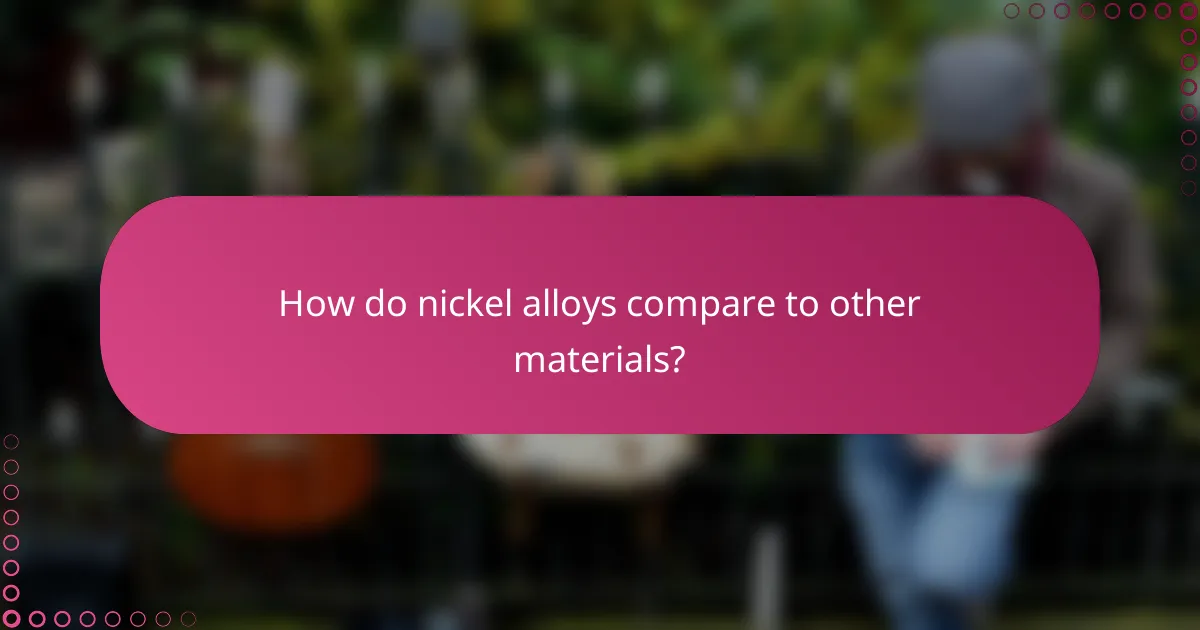Nickel alloys are renowned for their exceptional high-temperature resistance and durability, making them essential in demanding industrial applications. With a unique chemical composition that promotes oxidation resistance, alloys such as Inconel and Hastelloy are specifically engineered to maintain strength and integrity in extreme environments. Their ability to form protective layers further enhances their performance in aerospace, chemical processing, and power generation sectors.

What are the best nickel alloys for high-temperature resistance?
The best nickel alloys for high-temperature resistance include Inconel 625, Inconel 718, Monel 400, Hastelloy X, and Nickel 200. These materials are specifically designed to withstand extreme temperatures and oxidative environments, making them ideal for applications in aerospace, chemical processing, and power generation.
Inconel 625
Inconel 625 is known for its exceptional high-temperature strength and oxidation resistance. This alloy performs well in temperatures up to approximately 1,000°F (538°C) and is often used in jet engines and chemical processing equipment.
Its unique composition includes nickel, chromium, and molybdenum, which contribute to its durability and resistance to pitting and crevice corrosion. When selecting Inconel 625, consider its weldability and ability to maintain structural integrity under stress.
Inconel 718
Inconel 718 is a precipitation-hardenable nickel-chromium alloy that excels in high-temperature applications, typically up to around 1,200°F (649°C). It is widely used in aerospace components and gas turbine engines due to its excellent mechanical properties and resistance to oxidation.
This alloy can be easily fabricated and welded, making it a versatile choice for complex shapes and designs. When choosing Inconel 718, assess its performance in specific environments, especially where high strength and fatigue resistance are critical.
Monel 400
Monel 400 is a nickel-copper alloy that offers good high-temperature resistance, particularly in marine and chemical environments. It maintains its strength and corrosion resistance at temperatures up to about 1,000°F (538°C).
This alloy is particularly effective against seawater and acidic conditions, making it suitable for applications like pumps and valves in marine settings. When using Monel 400, consider its lower strength compared to other nickel alloys when exposed to extreme temperatures.
Hastelloy X
Hastelloy X is a nickel-chromium-molybdenum alloy that is highly regarded for its performance in high-temperature applications, often up to 2,000°F (1,093°C). It is commonly used in aerospace and industrial furnace applications due to its excellent oxidation resistance.
This alloy is known for its ability to withstand thermal cycling and is often chosen for components that experience extreme thermal stresses. When selecting Hastelloy X, evaluate its compatibility with the specific environment and operational conditions.
Nickel 200
Nickel 200 is a commercially pure nickel alloy that offers good mechanical properties and corrosion resistance at elevated temperatures, typically up to 600°F (316°C). It is often used in chemical processing and food handling applications.
This alloy is characterized by its excellent ductility and weldability, making it suitable for forming and fabricating. When considering Nickel 200, keep in mind its limitations in high-temperature strength compared to other nickel alloys, particularly in oxidative environments.

How do nickel alloys resist oxidation?
Nickel alloys resist oxidation primarily through their chemical composition and the formation of protective layers. These alloys contain elements that enhance their ability to withstand high temperatures and corrosive environments, making them ideal for demanding applications.
Chromium content
Chromium is a key element in many nickel alloys, significantly enhancing their oxidation resistance. Typically, alloys with chromium content ranging from 15% to 30% exhibit superior performance in high-temperature conditions. The presence of chromium helps to form a stable oxide layer that protects the underlying metal from further oxidation.
Protective oxide layer
The protective oxide layer formed on the surface of nickel alloys is crucial for their oxidation resistance. This layer acts as a barrier, preventing oxygen from penetrating and reacting with the metal. In many cases, this oxide layer can self-repair if damaged, maintaining the integrity of the alloy over time.
Temperature stability
Nickel alloys are designed to maintain their structural integrity at elevated temperatures, often exceeding 1,000°C. Their ability to resist oxidation at these temperatures is essential for applications in industries such as aerospace and power generation. When selecting a nickel alloy, consider the specific temperature range and environmental conditions to ensure optimal performance.

What are the applications of nickel alloys in high-temperature environments?
Nickel alloys are widely used in high-temperature environments due to their exceptional resistance to oxidation and durability. These materials maintain their strength and structural integrity under extreme conditions, making them ideal for various industrial applications.
Aerospace components
In aerospace, nickel alloys are crucial for components that must withstand high temperatures and stresses, such as turbine blades and combustion chambers. Their ability to resist thermal fatigue and oxidation ensures reliability and performance in flight conditions.
Common nickel alloys used in aerospace include Inconel and Hastelloy, which offer excellent mechanical properties and corrosion resistance. These materials are often selected based on specific performance requirements and environmental conditions.
Gas turbine engines
Gas turbine engines utilize nickel alloys for parts exposed to extreme heat and pressure, such as the hot section components. These alloys can endure temperatures exceeding 1,000°C while maintaining their mechanical properties, which is essential for engine efficiency and safety.
Manufacturers often choose nickel-based superalloys for their ability to resist creep and thermal fatigue. This selection helps improve engine performance and longevity, reducing maintenance costs over time.
Heat exchangers
Nickel alloys are also employed in heat exchangers, particularly in applications involving corrosive environments and high temperatures. Their resistance to oxidation and scaling allows for efficient heat transfer and prolonged service life.
In industries such as petrochemical and power generation, nickel alloys like Monel and Incoloy are preferred for their durability and ability to withstand harsh conditions. Proper material selection can significantly enhance the reliability and efficiency of heat exchange systems.

What factors should be considered when selecting nickel alloys?
When selecting nickel alloys, consider factors such as temperature range, corrosion resistance, and mechanical properties. These elements significantly influence the performance and longevity of the alloy in specific applications.
Temperature range
The temperature range is crucial when choosing nickel alloys, as different alloys perform optimally at varying temperatures. High-temperature nickel alloys can withstand extreme heat, often exceeding 1,000°C (1,832°F), making them suitable for applications like gas turbines and aerospace components.
When selecting an alloy, assess the maximum operating temperature and the thermal cycling conditions it will face. For instance, alloys like Inconel 600 are effective in high-temperature environments, while others may lose strength or become brittle.
Corrosion resistance
Corrosion resistance is a key factor in the longevity of nickel alloys, particularly in harsh environments. Nickel alloys are often chosen for their ability to resist oxidation and other corrosive processes, which can significantly reduce maintenance costs and extend service life.
For example, Inconel 625 is renowned for its excellent resistance to pitting and crevice corrosion, making it ideal for marine and chemical processing applications. Always evaluate the specific corrosive agents present in your environment to select the most suitable alloy.
Mechanical properties
The mechanical properties of nickel alloys, including tensile strength, ductility, and fatigue resistance, are essential for ensuring structural integrity under load. Different alloys exhibit varying levels of strength and flexibility, which can influence their suitability for specific applications.
For instance, alloys like Monel 400 offer good mechanical strength and are resistant to stress corrosion cracking, making them useful in oil and gas industries. Consider the load conditions and environmental factors when assessing the mechanical properties of the alloy for your project.

How do nickel alloys compare to other materials?
Nickel alloys are known for their high-temperature resistance, durability, and oxidation resistance, making them superior in specific applications compared to other materials. They excel in environments where strength and corrosion resistance are critical, such as in aerospace and chemical processing industries.
Versus stainless steel
Nickel alloys generally outperform stainless steel in extreme temperature and corrosive environments. While stainless steel is suitable for many applications, it may not withstand the same high temperatures or aggressive chemicals as nickel alloys.
For example, nickel-based superalloys can maintain structural integrity at temperatures exceeding 1,000°C, while many stainless steels begin to lose strength at lower temperatures. This makes nickel alloys a preferred choice in turbine engines and heat exchangers.
Versus titanium
Nickel alloys and titanium both offer excellent strength-to-weight ratios, but nickel alloys typically provide better oxidation resistance at high temperatures. Titanium is lighter, which can be advantageous in aerospace applications, but it may not perform as well in high-temperature environments.
In applications like gas turbines, nickel alloys can endure prolonged exposure to heat and corrosive gases, while titanium may require protective coatings to achieve similar performance. This trade-off is crucial when selecting materials for specific engineering challenges.
Versus carbon steel
Nickel alloys significantly outperform carbon steel in terms of corrosion resistance and high-temperature performance. Carbon steel is prone to rust and degradation in harsh environments, while nickel alloys maintain their properties under extreme conditions.
For instance, in chemical processing plants, using nickel alloys can reduce maintenance costs and downtime due to their durability. In contrast, carbon steel may require frequent replacement or protective coatings, leading to higher long-term expenses.

What are the benefits of using nickel alloys?
Nickel alloys offer significant advantages such as high-temperature resistance, oxidation resistance, and exceptional durability. These properties make them ideal for demanding applications in industries like aerospace, chemical processing, and power generation.
Durability
Nickel alloys are known for their remarkable durability, which stems from their ability to withstand extreme conditions without degrading. They resist wear and corrosion, making them suitable for long-term use in harsh environments.
When selecting a nickel alloy for durability, consider factors such as the specific application and operating conditions. For instance, alloys like Inconel and Monel are often chosen for their strength and resistance to oxidation at high temperatures, which can exceed 1,000°C in some cases.
To maximize the durability of nickel alloys, ensure proper maintenance and regular inspections. Avoid exposure to environments that may lead to stress corrosion cracking, especially in chloride-rich settings, which can compromise the integrity of the material over time.


